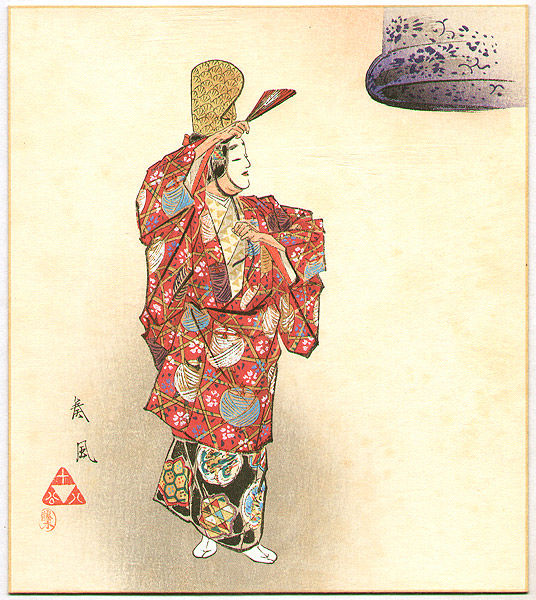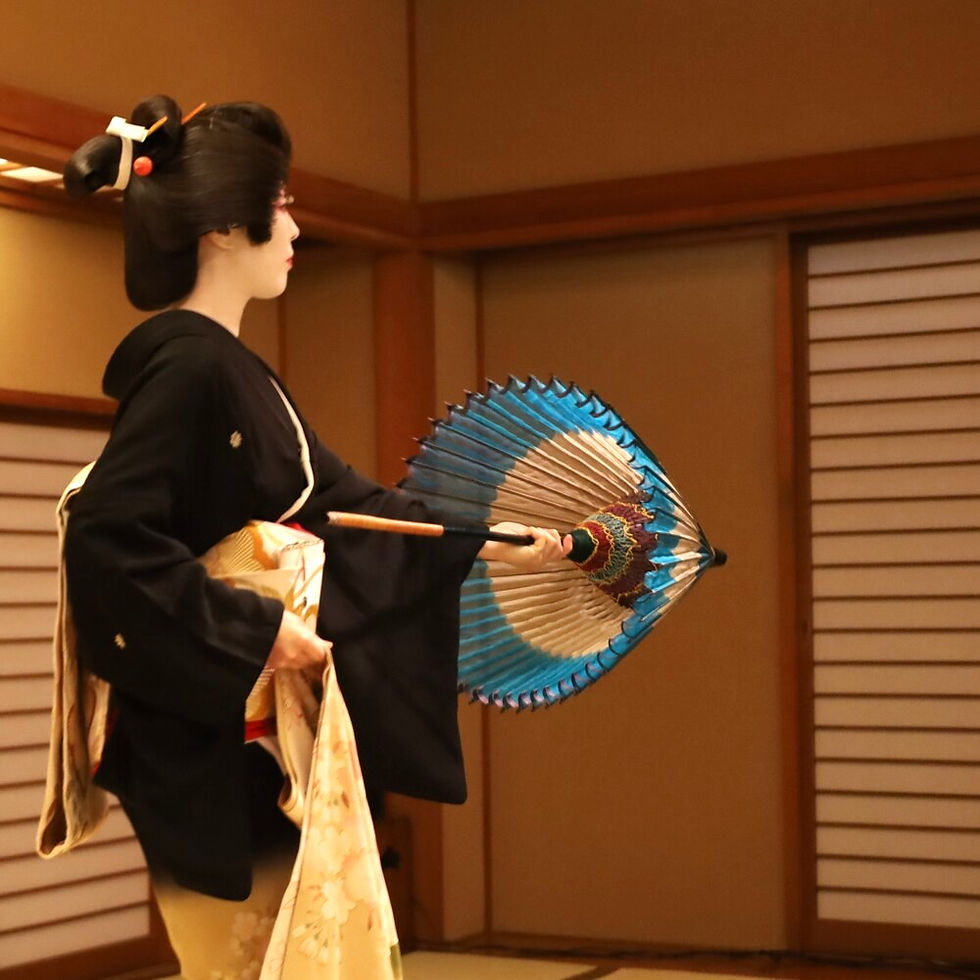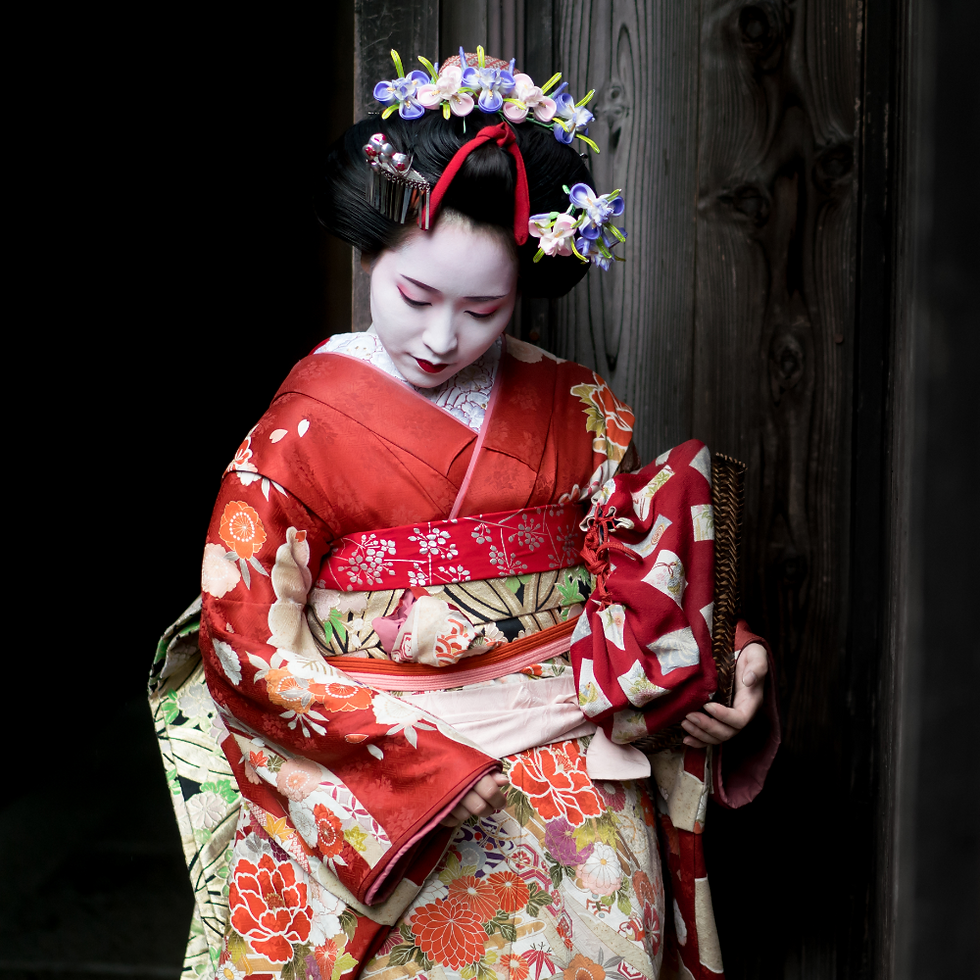What Geisha Really Do: The Secret of Traditional Japanese Dance in Kyoto and Tokyo
- Shinya Yamada
- Aug 25
- 10 min read
Updated: Aug 30

Imagine the scene: in an intimate banquet room, a geisha rises to perform. With the elegant arc of a fan and rhythmic steps in tabi socks, she captivates everyone present. You would surely sigh at her beauty.
This mesmerizing performance is the very heart of a geisha's profession and a vital part of her work. So, what do geisha really do? First and foremost, they are masters of an art form called Nihon buyo (Traditional Japanese Dance).
But the world of Japanese dance holds a secret that, outside of professional dancers, even most Japanese people do not know. It is a world shaped by two contrasting souls: the serene Mai (舞), a dance of stillness rooted in Noh, and the vibrant Odori (踊り), a dance of energy born from Kabuki and festive traditions.
This guide will unravel it all for you. By the time you finish reading, you will understand everything from the refined dance at a private geisha banquet to the joyous, communal steps of a summer Bon Odori festival.
Welcome to the secret world of Traditional Japanese Dance.

What is "Nihon buyo"? The Two Souls of Japanese Geisha Dance
The term "Nihon buyo" is surprisingly new, created in the Meiji period as a translation for the Western word "dance." The secret to its meaning is hidden within its kanji characters: 舞踊 (Buyo). This single word is a combination of two older, distinct traditions: "Mai" (舞) and "Odori" (踊り).
And who are the most famous practitioners of this art? The geisha. The name "geisha" (芸者) itself means "person of art," and Nihon buyo is the quintessential Japanese dance that these "people of art" perform.
Understanding the fundamental difference between "Mai" and "Odori" is, therefore, the first secret to knowing what a geisha really does.
"Mai" - The Dance of the Soul, Rooted in Noh
Mai is the older of the two traditions, primarily developed in the ancient capitals of Kyoto and Osaka (the Kamigata region). Its spirit is deeply connected to the serene, spiritual world of Noh.
Originally a sacred ritual performed by individuals with exceptional qualifications, Mai evolved as an intimate art form for small audiences in the tatami mat rooms of teahouses (ozashiki). The movements are therefore subtle and controlled. The foundation of Mai is suri-ashi, a smooth, gliding footwork that keeps the feet close to the floor, as if not to stir up dust. The motion is primarily horizontal, based on graceful circling and turning.
The expression in Mai is internal. Emotions are not explicitly shown but are allowed to emanate from within, creating an atmosphere of profound, quiet grace. It is a dance of the soul, designed for quiet contemplation.

"Odori" - The Dance of the People, Born from Kabuki and Festivals
Odori, in contrast, was born from the vibrant, populist energy of Kabuki in Edo (modern-day Tokyo). Its very name contains the character for "jump" (躍), hinting at its dynamic and rhythmic nature.
Designed for large theaters and public festivals, the movements of Odori are bigger, more expressive, and often vertical, including lively steps and jumps. The choreography is clear and distinct, telling a story or expressing a character's emotions in an open, external way that is easy for a large audience to understand and enjoy.
Perhaps the most famous and accessible example of Odori that every traveler to Japan can encounter is Bon Odori. During the summer, towns across Japan hold these lively festivals, where everyone—young and old, local and visitor—dances together in a circle to the powerful beat of taiko drums.
One of the most spectacular of these is the Awa Odori in Tokushima, which is famous worldwide. While Awa Odori began as a communal Bon dance, it also evolved into an elegant entertainment form performed by geisha in traditional restaurants (ryotei). This showcases how a folk dance can be elevated into a refined art form.
This communal, joyous, and energetic spirit, whether in a village circle or on a professional stage, is the very heart of Odori. It is a dance of the people, designed for participation and shared celebration.

Further Reading: The Two Pillars of Japanese Performing Arts
To truly understand the soul of "Mai" and "Odori," one must first know their origins. Discover the profound difference between Noh and Kabuki, the two great parent arts of Japanese dance, in our in-depth guide.

A Journey Through History: How a Unified Art Form was Born
The origins of Japanese dance are as old as the myths themselves. It is said to have begun when the goddess Ame-no-Uzume-no-Mikoto danced to lure the sun goddess Amaterasu out of a cave where she was hiding. From this divine beginning, dance in Japan has always been a form of prayer and a way to connect with the gods.
The art form we know today as Nihon buyo takes its primary inspiration from the dance styles of Kabuki, which blossomed in the Edo period. Initially performed only by men, it gradually evolved into a rich narrative art. A key feature of its development was the addition of female performers, which greatly expanded its expressive range.
In the Meiji period (late 19th century), as Japan opened to the West, the term "Nihon buyo" was coined by scholars like Tsubouchi Shoyo to distinguish it from Western "dance." It was at this time that Nihon buyo truly became an independent stage art, separate from Kabuki. A major force in this evolution was the geisha of the kagai (geisha district). They not only performed the art at the highest level in their banquets but also helped popularize it as a refined hobby for ordinary people, ensuring its survival and continuation to this day.

The World of the Geisha: Where "Mai" and "Odori" Come to Life
Now that we understand the two souls of Japanese dance, "Mai" and "Odori," we can finally explore the world where they are most beautifully expressed: the world of the geisha.
To truly answer the question, "what geisha do," we must look at how they bring these traditional Japanese dances to life in the intimate setting of the ozashiki (banquet room).
Tachikata and Jikata: The Specialist Roles of the Performers
A geisha banquet is not a solo performance; it is a collaborative masterpiece created by two types of highly trained artists.
Tachikata (立方): The Dancers
The Tachikata are the main dancers. Through the art of Nihon buyo, they tell stories and express a vast range of emotions, from the quiet elegance of "Mai" to the dynamic energy of "Odori." When you see a geisha performing with a fan, she is a Tachikata. They are often the ones who wear the iconic white makeup (oshiroi).
Jikata (地方): The Musicians
The Jikata are the masters of music who create the soundscape of the banquet. Their primary instrument is the shamisen, but they also provide the vocals (nagauta, etc.) that guide the story of the dance. They are the directors and the orchestra, controlling the rhythm and mood of the entire evening. Often, senior geisha will perform as Jikata, and they also lead the ozashiki-asobi (games). Typically, the Jikata do not wear white makeup, allowing the focus to remain on the dancers.

It is this perfect harmony between the visual beauty of the Tachikata and the auditory artistry of the Jikata that creates an unforgettable geisha experience.
The Five Great Schools of Tokyo: A Legacy of Edo
All five of the largest and most influential schools of Nihon buyo originated in Edo (Tokyo), their styles deeply intertwined with the world of Kabuki.
Nishikawa-ryū (西川流)
Founded between 1688 and 1704 by Nishikawa Senzō I. With over 300 years of history, it is the origin point for many other schools.
Fujima-ryū (藤間流)
Founded between 1704 and 1710 by Fujima Kanbei I. It later split into the Kanjūrō family in Kayabacho and the Kan'emon family in Hamacho.
Bandō-ryū (坂東流)
Founded between 1804 and 1830 by the famous Kabuki actor Bandō Mitsugorō III. This school always treats its pieces theatrically, placing great importance on "acting" within the dance.
Hanayagi-ryū (花柳流)
Founded in 1849 by Hanayagi Jusuke. Today, it is the largest school, boasting approximately 15,000 certified professional dancers due to its strong organizational power.
Wakayagi-ryū (若柳流)
Founded in 1893 by Hanayagi Yoshimatsu, who later changed his name to Wakayagi Yoshimatsu. As it developed primarily within the kagai (geisha world), it is known for its graceful hand gestures and refined style of dance.
(Reference) Kyo-mai "Inoue-ryū"
Founded during the Kansei era (1789–1801) by Inoue Sato (the first Inoue Yachiyo), who served as a dance instructor to the noble Konoe family, this school is based on the culture of the Imperial Court. It has been passed down to the present day, incorporating elements of highly refined dance with themes and movements from Nohgaku and Bunraku puppet theater. As a dance passed down by women, its expression is known for its highly characteristic technique, which includes sharp, linear movements within an overall softness.
So, as we have seen, the most influential schools of Nihon buyo were born in Tokyo and shaped by the world of Kabuki. This historical fact leads to a fascinating and unexpected story when we look at the dance styles practiced in the geisha districts of Japan's two great capitals: Kyoto and Tokyo.

Dance in the Geisha Districts: A Surprising Tale of Two Cities, Tokyo and Kyoto
This is where the theoretical difference between "Mai" and "Odori" becomes a vibrant, living reality.
The origin of the kagai (geisha district) dates back to 1587, when Toyotomi Hideyoshi officially sanctioned the Kamishichiken district in Kyoto. It is natural, therefore, for many to think that the center of geisha culture, both past and present, is Kyoto.
Indeed, in Gion Kobu, the most prestigious of Kyoto's five kagai, the elegant "Mai" (舞) style of dance is carefully preserved. Its representative performance is the famous "Miyako Odori" (known overseas as the "Cherry Dance"), which has the longest history, beginning in 1872. This is the Inoue-ryū style, which has its roots in the dances of the Imperial Court and is heavily influenced by Noh. (Interestingly, despite being a form of "Mai," it is called "Miyako Odori," using the word for the other dance style.)
However, here lies a surprising fact that many people do not know. With the exception of Gion Kobu, the other four of Kyoto's five famous kagai—Miyagawacho, Pontocho, Kamishichiken, and Gion Higashi—primarily feature dance schools (Wakayagi-ryū, Onoe-ryū, Hanayagi-ryū, Fujima-ryū) that all originated in Tokyo (Edo) and belong to the "Odori" (踊り) lineage.

Dance Schools of Kyoto's 5 Kagai
Gion Kobu: Inoue-ryū ("Kyo-mai," a style of Mai)
Miyagawacho: Wakayagi-ryū (an Odori style)
Pontocho: Onoe-ryū (an Odori style)
Kamishichiken: Hanayagi-ryū (an Odori style)
Gion Higashi: Fujima-ryū (an Odori style)
Dance Schools of Tokyo's 6 Kagai
This is fascinating historical proof of the nationwide influence that the "Odori" style, which developed in Edo (Tokyo) alongside Kabuki, truly had.
This fact gives you a new perspective when asking which city you should choose for your geisha experience. If you are seeking a quiet, more introspective beauty, the "Mai" of Kyoto's Inoue-ryū would be a supreme experience.
However, if you enjoy the dynamic, story-rich entertainment of Kabuki, which fascinates so many travelers around the world, then the "Odori" of Tokyo's geisha, which inherits that spirit, may be the more deeply resonant and unforgettable experience for you. It is the lively spirit of Edo, still dancing in the heart of modern Tokyo.
We hope you now understand that geisha experiences are not only in Kyoto—and that there are compelling reasons to choose Tokyo proactively.

The Music of the Geisha Dance: A Guide to the Sounds of Nihon buyo
In Nihon buyo, the dance and the music are inseparable. The rhythm, melody, and story provided by the musicians are the canvas upon which the dancer paints their art. While the shamisen is the primary accompanying instrument, the specific genre of music, known as hōgaku (邦楽), defines the soul of the performance.
Broadly, this music can be divided into two categories: lyrical Uta-mono ("sung things") and narrative Katari-mono ("narrated things").
Uta-mono (唄物) – The Music of Song
This category focuses on lyrical and emotional expression rather than a concrete storyline.
Jiuta (地歌): The oldest genre of shamisen music, Jiuta developed primarily in the Kamigata region (Kyoto and Osaka). It is known for its refined and introspective quality, focusing on evoking a particular emotion or atmosphere.
Nagauta (長唄): Meaning "long song," Nagauta developed as the primary dance music for Kabuki theatre in Edo (Tokyo). Due to its connection with the diverse world of Kabuki, its repertoire is incredibly varied, ranging from upbeat and festive to deeply melancholic.
Katari-mono (語り物) – The Music of Narrative
This category of music is all about storytelling. The main genre is called Jōruri (浄瑠璃), which has several famous schools, each with its own unique dramatic style.
Gidayū-bushi (義太夫節): Originating in Osaka with Takemoto Gidayū, this style is known for its powerful, weighty, and realistic depiction of human drama and complex relationships. It is the signature music of Bunraku puppet theatre.
Tokiwazu-bushi (常磐津節): Founded in Edo by Tokiwazu Mojitayū, this style is known for its strong core narration and chic (shādatsu) sensibility, making it a popular accompaniment for Kabuki dance.
Kiyomoto-bushi (清元節): Also founded in Edo, Kiyomoto is known for its lyrical, often high-pitched and passionate emotional expression, influenced by Nagauta.
Shinnai-bushi (新内節): A particularly poignant and narrative-driven style, Shinnai-bushi became immensely popular in Edo for its dramatic tales of star-crossed lovers, double suicides, and human drama. This tradition is kept vibrantly alive today by masters like Tsuruga Wakasajō XI, a Living National Treasure who is based in Kagurazaka, Tokyo—the very home of our traditional cultural experiences. His presence and performances in the neighborhood are a testament to how this living history continues to thrive in the heart of the city.

Conclusion: From Knowledge to an Unforgettable Tokyo Experience
As we've journeyed through the world of Nihon buyo, you've discovered its secret: the two souls of the serene, internal "Mai" and the vibrant, expressive "Odori." Understanding this distinction is the key that unlocks a much deeper appreciation of Japanese culture.
This journey also reveals a surprising truth: while the geisha tradition began in Kyoto, the heart of modern Nihon buyo beats strongest in Tokyo. The majority of the dance styles seen today—even in four of Kyoto's five famous flower towns—and more than half of the accompanying music genres originated in the dynamic world of Edo-period Kabuki.
This is why, for many international visitors, a Tokyo geisha experience can be so uniquely captivating. The energetic, story-driven "Odori" style is accessible and thrilling, much like the Kabuki theatre that so many have come to love. It is a dance that is meant to be shared and enjoyed openly.
We hope you now understand that an authentic geisha experience is not only in Kyoto—and that there are compelling reasons to proactively choose Tokyo.
Don't just read about this living history. Come and feel its energy. Let us guide you to an unforgettable evening of authentic "Odori" in the heart of Tokyo, an experience that will become the most cherished memory of your trip to Japan.
Sources:
Geisha Experience in Tokyo





![The Ultimate Tokyo Geisha Experience: A Guide to Kagurazaka in Summer [2025 Edition]](https://static.wixstatic.com/media/983a60_140a5cee72634e17836d6e70148bafdb~mv2.jpg/v1/fill/w_661,h_661,al_c,q_85,enc_avif,quality_auto/983a60_140a5cee72634e17836d6e70148bafdb~mv2.jpg)
Comments